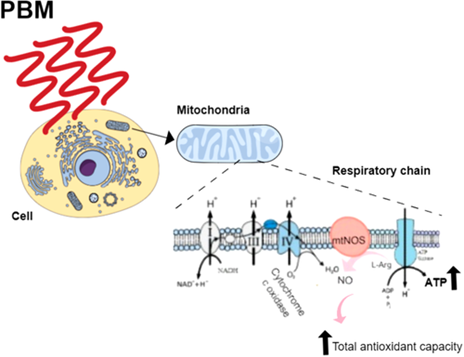The Of Photobiomodulation
Wiki Article
Little Known Questions About Photobiomodulation.
Table of ContentsThe Single Strategy To Use For PhotobiomodulationNot known Facts About PhotobiomodulationFacts About Photobiomodulation UncoveredPhotobiomodulation - An Overview
Laser therapy is a clinical treatment that makes use of concentrated light to boost a process called. Throughout PBM, photons go into the cells and connect with the cytochrome c complex within mitochondria. This communication sets off a biological cascade of events that brings about an increase in mobile metabolic process, which can as well as increase the healing procedure.There is consensus that the application of a healing dosage of light to impaired or inefficient tissue leads to a mobile action moderated by mitochondrial systems. Photobiomodulation. Researches have shown that these adjustments can impact discomfort and inflammation, in addition to, tissue repair service
Changes in ATP, responsive oxygen varieties and nitric oxide follow light absorption by Cc, O. These impacts are redox state and dose dependent.

Getting The Photobiomodulation To Work
PBM tools have been gotten rid of for marketing by FDA with the Premarket Notification/510( k) process as adjunctive gadgets for the momentary relief of pain. These clearances were based on the presentation of clinical data to support such cases (Photobiomodulation). In this therapy, a light source is put near or touching the skin, enabling the light energy (photons) to permeate tissue where it engages with chromophores found in cells resulting in photophysical and photochemical modifications that lead to modifications at the molecular, cellular and cells degrees of the bodyRemarkably, current study shows that light can boost performance in regular cells and cells. The possible applications of PBMT are many and are being explored experimentally at the fundamental scientific research, pre-clinical and professional level. The current medical uses are for the alleviation of discomfort and inflammation and the treatment of sporting activities injuries.

The treatment parameters and number of sessions required for PBMT depend on place and reason. PBMT usually needs greater than one therapy for optimum discomfort relief. It may take a number of therapies for the outcomes to come to be noticeable. reports that it can take anywhere from 8 to 30 sessions for a treatment to be totally effective, and some individuals locate it required to go through treatment two to four times per week.
Photobiomodulation Fundamentals Explained
Therapy criteria for PBMT were initially developed using cells artificial insemination and in little pet models. These treatment criteria generally had a from this source reduced irradiance and fluence and functioned well for cutaneous applications. When medical professionals began to use PBMT to treat frameworks that were situated deeper in the body, they used these criteria with adverse outcomes.
We now comprehend that these unfavorable studies was because of inaccurate device and treatment criteria for transcutaneous therapy of deeper frameworks. Recent advances in laser treatment gadgets and more study right into the proper does have substantially improved the outcomes of PBMT. For treating deep tissues, the wavelength of light used figures out the depth of penetration into a cells.
It is vital that a medical professional makes use of the appropriate wavelength of light and parameters to treat a problem. One wavelength and one set of treatment criteria will certainly not be effective for all conditions. Adverse side effects have actually not been reported from the usage of PBMT.
5 Simple Techniques For Photobiomodulation
In the first experiment, Dr. Endre Mester, used cut rats and observing exactly how the laser affected their ability to expand hair contrasted to the team that was not receiving LLLT. He found that the group of mice getting LLLT had the ability to expand their hair back much more quickly than the team of computer mice that didn't obtain LLLT (Hoon C, et al; 2012).This treatment is called this method to distinguish the distinction between the lasers some careers make use of to cut (eg. Low-level light treatment is pain-free, non-invasive therapy.
LLLT has a biphasic action, websites implying that lower dosages are generally attended be extra helpful than greater go to this website dosages. That being stated, dosages higher or lower than the optimal dosage doesn't impact (Hoon C, et alia; 2012). Consequently, it can be tough to have researches on LLLT with numerous criteria.
Some firms integrated both (LED and laser) to provide an extra well-shaped treatment given that lasers can permeate much deeper than LED and infrared light (Norman Doidge, The Mind's Way of Healing, 2015). During treatment, the area that is being treated is subjected to LED light from a Biography, Flex Laser, which is at 660 nm wavelength, followed by infrared light at 830-840 nm wavelength.
Report this wiki page